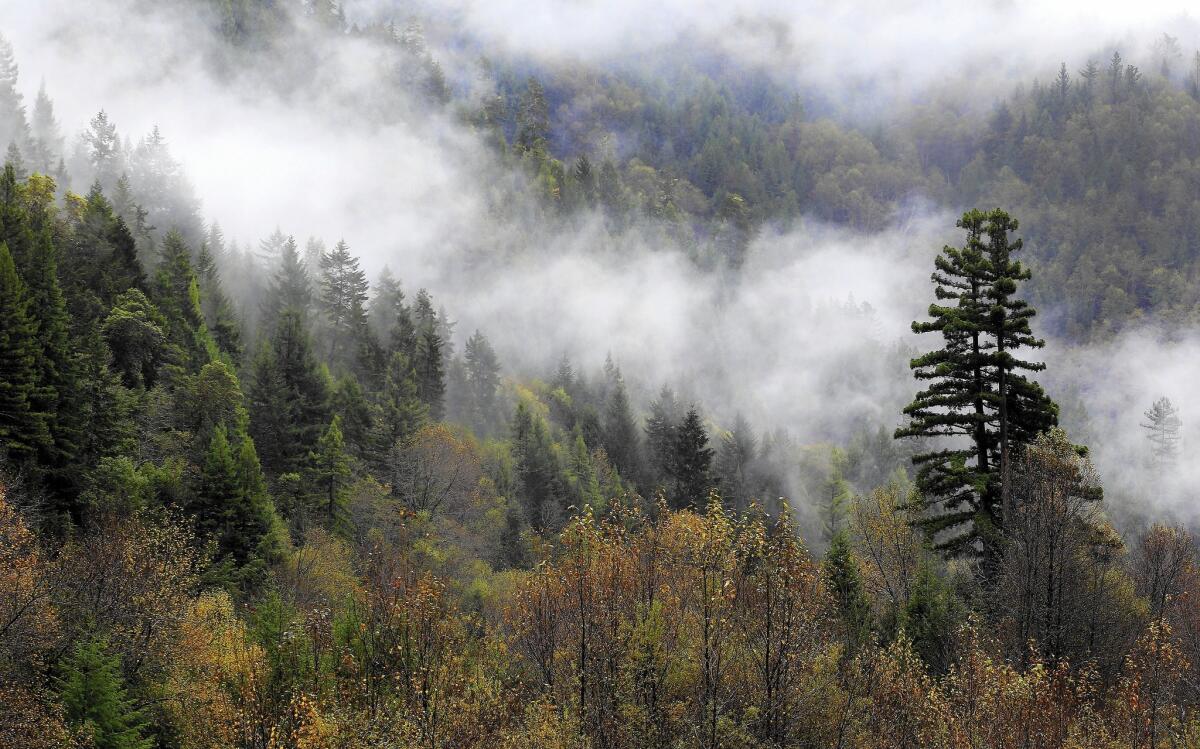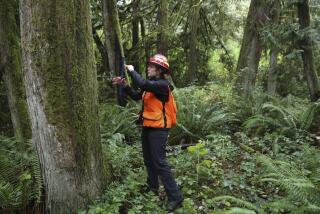Water stress takes toll on California’s large trees, study says

Drought, fire-suppression techniques and changes in land use have made California forests denser with smaller trees and more susceptible to fast-moving wildfires, a study to be released Tuesday has found.
Researchers at UC Berkeley, UC Davis and the U.S. Geological Survey compared tree surveys conducted between 1929 and 1936 with surveys conducted between 2001 and 2010. They found that large tree density fell across California, with declines of as much as 50% in the Sierra Nevada highlands, the south and central Coast Ranges and Northern California. At the same time, the density of smaller trees increased dramatically.
Drier conditions caused by drought reduce water available for trees to grow while making it easier for fires to start and spread. Scientists say the changes raise crucial questions about how California manages its forest land to prevent and control wildfires as temperatures increase.
“The current drought in California highlights our need to understand the role of water balance in these systems and how it will be affected by global temperature rise,” said the study’s lead author, Patrick McIntyre. “Forests and woodlands cover a third of California, so this has important implications for our state.”
The study, to be published in the journal Proceedings of the a National Academy of Sciences, found that declines in large tree density were greatest in areas with the greatest increase in water stress (when there is more demand for water than water available).
Large trees, which are important for storing carbon from the air and providing food and habitat, can be more vulnerable to drought and water stress, McIntyre said.
“Declines in their numbers are concerning,” he said.
Researchers found that densities of small trees increased in almost every region of California surveyed. Small tree density within the Sierra Nevada highlands more than doubled, and it increased more than 50% in the Sierra Nevada foothills, the North Coast region and the Transverse and Peninsular ranges.
Oak trees, which thrive in warm, dry climates, increased in density as pine density decreased, the researchers found.
California has a Mediterranean climate, McIntyre said. Almost all of its precipitation comes in the winter, and in the summer it dries out. A lack of year-round water availability limits the amount of water stored in the soil and can hinder tree growth, he said.
Higher temperatures, which cause earlier snowmelt and more water loss through evaporation and plant transpiration, compound the water scarcity problem for larger trees.
Fire and timber management practices also play a major role in forest structure changes, the researchers said. The common reaction to wildfires is to quickly suppress them. But the study raises questions about how to adjust intervention techniques to allow healthy burns without jeopardizing human safety.
Mark Schwartz, professor of environmental science and policy at UC Davis and director of the John Muir Institute of the Environment, studies the effect of climate change on wildfires.
A denser forest allows fire to travel faster, causing more devastation, he said. After a fire, smaller trees grow that are more likely to catch fire, and the cycle continues.
“These are historically fire-maintained ecosystems,” Schwartz said. “The firemen are faced with this notion of when a fire is reported and started, do they go out and bring out helicopters, trucks and people and put the fire out, or do they let it burn?”
But prescribed burns and tree thinning can be controversial, said David Ackerly, a researcher involved in the study and professor of integrative biology at UC Berkeley.
Duane Shintaku, deputy director for resource management for the California Department of Forestry and Fire Protection, said letting a fire burn is never an option. The agency’s goal is to keep fires to less than 10 acres, he said.
“We’re protecting private lands and public lands where there’s many lives at stake and homes at stake, [and] infrastructure … and you can’t tell someone ‘You know what? We’re just going to see what would happen if we wait to see if it gets big,’” Shintaku said.
Over the last 50 years, Shintaku said, logging has decreased significantly, which also contributes to the increased density of California forests.
The department has a number of techniques to manage forests, Shintaku said, including using machines and people to thin trees, harvesting usable materials for wood products and energy conversion, and igniting small prescribed burns. The strategy keeps forests healthy by eliminating diseased trees and harmful insects.
From July 1, 2012, to June 30, 2013, Cal Fire’s Vegetation Management Program staff burned 7,786 acres of trees with prescribed fires. An additional 8,777 acres of trees were mechanically removed, usually when burning was too dangerous.
Still, California has much work to do to improve forest management, Shintaku said.
“We have to start going after it because we’re playing catch-up right now,” he said.
taylor.goldenstein@latimes.com
More to Read
Start your day right
Sign up for Essential California for news, features and recommendations from the L.A. Times and beyond in your inbox six days a week.
You may occasionally receive promotional content from the Los Angeles Times.







